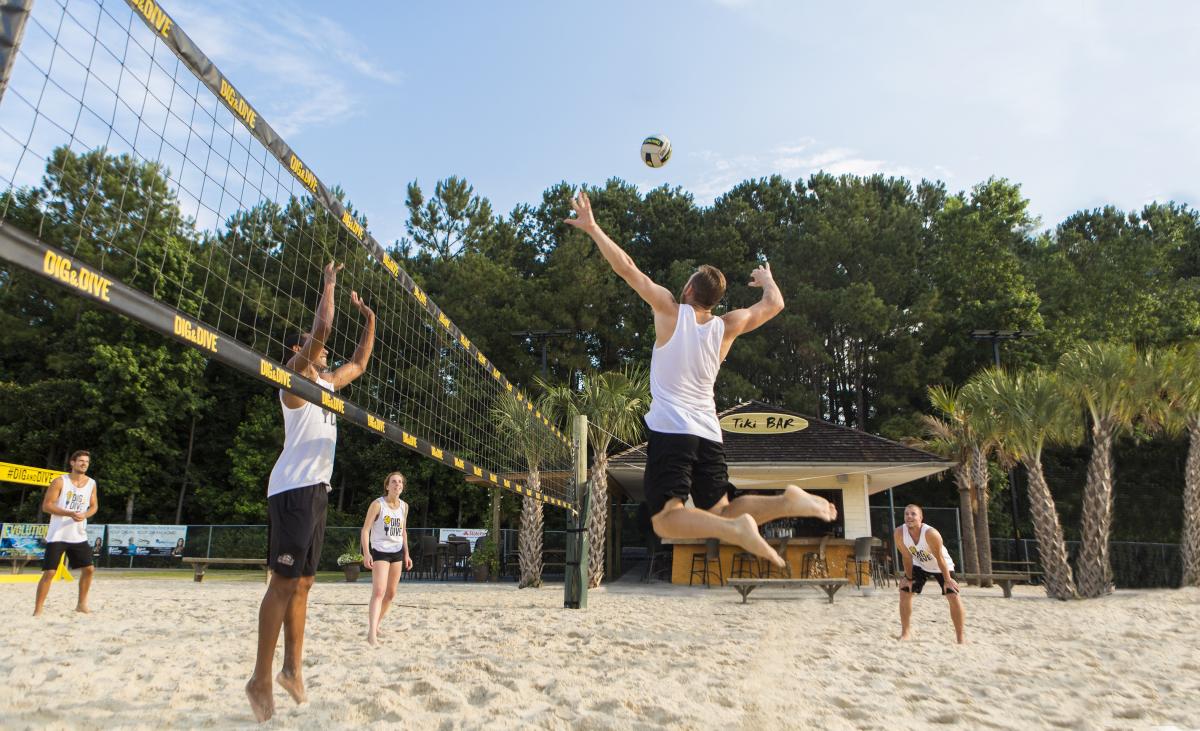The Physical Demands of Volleyball A Challenge for 55+ Players
Volleyball is a popular sport that requires a significant amount of physical activity, including jumping, quick movements, and continuous motion. While this can be an exciting and engaging experience for younger players, the physical demands of volleyball can pose a significant challenge for individuals aged 55 and above, who may be dealing with age-related physical limitations.
Cardiovascular Endurance
Volleyball is a fast-paced sport that requires sustained cardiovascular endurance. Older adults may struggle to maintain the necessary level of physical exertion required to keep up with the pace of the game, leading to fatigue and potential injury.
- Reduced lung capacity and oxygen intake: As people age, their respiratory system becomes less efficient, making it more difficult to sustain high levels of physical activity.
- Decreased muscle strength and endurance: Older adults often experience a decline in muscle strength and endurance, which can limit their ability to perform the repetitive movements and explosive actions required in volleyball.
- Decreased energy levels: Aging can lead to a decrease in overall energy levels, making it more challenging for older adults to maintain the high-intensity demands of volleyball.

Agility and Coordination
Volleyball requires quick movements, sharp reactions, and precise coordination, all of which can become more challenging for older adults as they age.
- Decreased reaction time: As people get older, their reaction time often slows down, making it more difficult to respond quickly to the ball and changes in play.
- Reduced flexibility and mobility: Age-related stiffness and decreased range of motion can hinder an older player’s ability to move effectively and execute the necessary volleyball skills.
- Balance and stability issues: Older adults may experience balance and stability problems, which can increase the risk of falls and other injuries during volleyball games.
Jumping Ability
Volleyball involves frequent jumping, both for serving and spiking the ball, as well as blocking and defending. This can be particularly demanding for older adults.
- Decreased leg strength and power: As people age, they often experience a decline in the strength and power of their leg muscles, making it more difficult to generate the necessary force for jumping.
- Joint issues: Older adults may be more prone to joint problems, such as arthritis, which can make jumping and landing difficult and potentially painful.
- Risk of impact-related injuries: The repetitive jumping and landing in volleyball can increase the risk of impact-related injuries, such as sprains, strains, and fractures, for older players.
Injury Risk
The physical demands of volleyball can heighten the risk of injury for older adults, who may be more susceptible to sports-related injuries due to age-related factors.
- Increased risk of overuse injuries: The repetitive motions and high-intensity movements in volleyball can lead to overuse injuries, such as tendinitis, bursitis, and stress fractures, which are more common in older adults.
- Longer recovery time: Older adults may take longer to recover from injuries, which can disrupt their ability to participate in volleyball consistently.
- Potential long-term consequences: Injuries sustained during volleyball may have more severe and long-lasting consequences for older adults, potentially affecting their overall health and quality of life.
- Importance of proper warm-up and cool-down: Older players should prioritize warming up before playing volleyball to prevent injuries and cooling down afterward to aid in recovery.
- Utilizing protective gear: Older adults should consider using supportive equipment, such as knee pads and ankle braces, to reduce the risk of impact-related injuries during volleyball games.
- Listening to their bodies: It’s essential for older players to listen to their bodies and not push themselves beyond their physical limits to avoid overexertion and potential injuries.
Overall, while the physical demands of volleyball can present challenges for 55+ players, taking precautions, listening to their bodies, and adapting their gameplay can help mitigate the risk of injuries and allow older adults to continue enjoying the sport.
See more: 55club
Adapting Volleyball Rules for 55+ Players: Can Modifications Address Physical Limitations?

As older adults face unique physical limitations that may affect their ability to play traditional volleyball, adapting the rules of the game can help make it more accessible and enjoyable for 55+ players. By implementing modifications that cater to the needs of older adults, clubs can create a welcoming environment that encourages participation and inclusivity.
Lowering the Net Height
One significant adaptation that can benefit older players is lowering the height of the net. A lower net reduces the need for frequent jumping and allows for less strenuous play, making it easier for older adults to participate without putting excessive strain on their bodies.
- Standard net height: The standard net height for men’s volleyball is 7 feet 11 5/8 inches (2.43 meters), and for women’s volleyball, it is 7 feet 4 1/8 inches (2.24 meters).
- Modified net height: Lowering the net to around 7 feet (2.13 meters) or even lower can make it more manageable for older players to reach and interact with the ball without having to jump as high.
Adjusting Court Dimensions
Modifying the dimensions of the volleyball court can also help accommodate the physical limitations of older adults. By reducing the size of the court, players can cover less ground and engage in shorter, less intense rallies.
- Standard court size: A standard volleyball court measures 29.5 feet (9 meters) wide and 59 feet (18 meters) long for indoor play, with a net height of approximately 7 feet 11 5/8 inches (2.43 meters).
- Modified court size: Creating a smaller court by narrowing the width and shortening the length can make it easier for older players to move around and participate in the game without feeling overwhelmed by the larger space.
Limiting Player Movement
To minimize the physical strain on older players, limiting the movement required during gameplay can be beneficial. Implementing rules that restrict excessive running and quick directional changes can help prevent injuries and ensure a more comfortable experience for 55+ participants.
- Designated player zones: Establishing specific zones on the court where players must remain during certain phases of the game can reduce the amount of running and jumping required.
- Rotational system: Implementing a rotational system that allows older players to switch positions strategically without constant movement can help conserve energy and prevent fatigue.
Allowing Underhand Serves
In traditional volleyball, players typically use overhand serves to start the game. However, for older adults who may struggle with overhead movements, allowing underhand serves can be a practical modification that enables them to participate more effectively.
- Reduced shoulder strain: Overhand serving requires a significant amount of shoulder strength and flexibility, which can be challenging for older players with limited mobility.
- Increased accuracy: Underhand serves are generally more accurate and easier to control, making them a suitable option for older adults looking to maintain consistency in their serves.
Incorporating Rest Periods
Recognizing the importance of adequate rest for older players, incorporating scheduled rest periods into the game can help prevent exhaustion and reduce the risk of overexertion.
- Timeout opportunities: Allowing for additional timeouts or extending the duration of regular timeouts can give older players the chance to catch their breath, hydrate, and regroup during intense gameplay.
- Substitution options: Providing more flexibility for substitutions can enable older players to rotate in and out of the game as needed, ensuring that everyone has sufficient breaks to recover.
By implementing these adaptations and modifications to the rules of volleyball, clubs can create a more inclusive and age-friendly environment that caters to the needs of 55+ players. These adjustments not only make the game more accessible but also enhance the overall experience for older adults looking to stay active and engaged in the sport.
Social Dynamics in Volleyball: Finding a Welcoming Environment for 55+ Players

In addition to the physical challenges that older adults may face when participating in volleyball, the social dynamics of the sport can also influence their overall experience. Creating a welcoming and supportive environment for 55+ players is essential for fostering a sense of belonging, camaraderie, and enjoyment within the club.
Inclusivity and Acceptance
Ensuring that 55+ players feel included and accepted within the volleyball club is crucial for their engagement and satisfaction. Promoting a culture of inclusivity where age is celebrated rather than stigmatized can help older adults feel valued and respected by their teammates.
- Embracing diversity: Encouraging players of all ages to interact and collaborate fosters a sense of unity and teamwork within the club, regardless of age differences.
- Respecting individual differences: Recognizing and respecting the unique abilities and limitations of older players can promote empathy and understanding among club members, creating a supportive and inclusive atmosphere.
Mentorship and Support
Establishing mentorship programs or buddy systems within the club can provide older players with guidance, encouragement, and support from their peers. Pairing experienced players with newcomers or older adults can facilitate skill development, social integration, and overall well-being.
- Skill-sharing opportunities: Encouraging older players to share their knowledge and expertise with younger teammates promotes intergenerational learning and strengthens relationships within the club.
- Emotional support network: Creating a support system where players can turn to each other for advice, motivation, and companionship enhances the sense of community and connection among club members.
Social Events and Activities
Organizing social events, team-building activities, and bonding opportunities outside of regular volleyball games can strengthen relationships, build rapport, and enhance the social aspect of the club for 55+ players.
- Group outings: Planning group outings, such as dinners, picnics, or recreational excursions, allows players to socialize in a relaxed setting and form deeper connections beyond the volleyball court.
- Celebrating milestones: Recognizing birthdays, anniversaries, and achievements among club members cultivates a sense of camaraderie and shared experiences, fostering a positive and supportive social environment.
Communication and Feedback
Maintaining open and transparent communication channels within the club enables 55+ players to voice their opinions, express their needs, and provide feedback on their experiences. Creating a platform for dialogue and collaboration promotes a culture of respect, trust, and mutual understanding.
- Regular team meetings: Holding regular team meetings or feedback sessions provides an opportunity for players to discuss concerns, suggest ideas, and address any issues related to their participation in the club.
- Constructive feedback mechanisms: Encouraging constructive feedback and active listening among club members promotes a culture of continuous improvement, adaptability, and responsiveness to the needs of 55+ players.
Recognition and Appreciation
Acknowledging the contributions, efforts, and achievements of 55+ players within the club reinforces their value, boosts morale, and fosters a sense of belonging and pride in their involvement in volleyball.
- Player spotlights: Highlighting individual accomplishments, milestones, or acts of sportsmanship through player spotlights or recognition ceremonies showcases the diverse talents and qualities of older players within the club.
- Team celebrations: Organizing team celebrations, awards ceremonies, or appreciation events can strengthen the sense of community, unity, and solidarity among club members, fostering a positive and inclusive social environment.
By prioritizing inclusivity, support, social engagement, communication, and recognition within the volleyball club, 55+ players can feel welcomed, valued, and connected to their teammates, enhancing their overall experience and enjoyment of the sport.
Finding Time for Volleyball: Balancing Practice and Other Commitments for 55+ Individuals

Balancing the demands of volleyball practice with other commitments and responsibilities can be a significant challenge for 55+ individuals. As older adults juggle various obligations, finding time for regular training sessions, games, and tournaments can require careful planning, time management, and prioritization of activities.
Prioritizing Health and Well-being
Making time for volleyball amidst busy schedules and competing priorities requires a commitment to prioritizing health and well-being. Recognizing the physical, mental, and social benefits of staying active through sports like volleyball can motivate 55+ individuals to carve out time for practice and games.
- Setting realistic goals: Establishing achievable fitness goals and objectives related to volleyball participation can help older adults stay motivated and focused on integrating the sport into their routine.
- Incorporating exercise into daily life: Finding creative ways to incorporate physical activity, such as volleyball drills, stretching exercises, or cardio workouts, into daily routines can help maintain consistency and progress in skill development.
Time Management Strategies
Effective time management strategies are essential for balancing volleyball commitments with work, family, and personal obligations. By implementing efficient planning techniques and organizational tools, 55+ individuals can optimize their schedules and allocate sufficient time for practicing and playing volleyball.
- Creating a structured schedule: Developing a weekly or monthly calendar that outlines volleyball practices, games, and events alongside other engagements helps older adults visualize their commitments and manage their time effectively.
- Prioritizing tasks: Identifying key priorities and allocating dedicated time slots for volleyball activities ensures that 55+ players can balance their responsibilities without neglecting their passion for the sport.
Flexibility and Adaptability
Remaining flexible and adaptable in scheduling volleyball activities is essential for accommodating unforeseen events, changes in plans, and unexpected circumstances that may arise for 55+ individuals. Embracing a mindset of adaptability allows older players to navigate challenges and adjust their routines accordingly.
- Embracing change: Being open to adjusting practice times, game schedules, or training formats in response to external factors demonstrates resilience and versatility in managing volleyball commitments.
- Seeking support and assistance: Engaging with teammates, coaches, or club organizers to communicate scheduling conflicts, seek alternative solutions, or delegate tasks can alleviate stress and facilitate smoother coordination of volleyball activities.
Self-care and Rest
Prioritizing self-care and allowing time for rest and recovery are vital components of maintaining a healthy balance between volleyball and other commitments for 55+ individuals. Recognizing the importance of downtime, relaxation, and rejuvenation supports overall well-being and prevents burnout.
- Listening to the body: Paying attention to physical cues, signs of fatigue, and indicators of overexertion enables older players to gauge their limits and adjust their training intensity or frequency accordingly.
- Incorporating rest days: Intentionally scheduling rest days between volleyball sessions, matches, or tournaments gives 55+ individuals the opportunity to recharge, recuperate, and prevent injury from excessive strain.
Goal Setting and Accountability
Establishing clear goals, tracking progress, and holding oneself accountable for consistent participation in volleyball activities can help 55+ individuals stay motivated, focused, and committed to their training regimen. By setting specific objectives and monitoring their achievements, older players can maintain their enthusiasm for the sport.
- SMART goal setting: Using the SMART criteria (Specific, Measurable, Achievable, Relevant, Time-bound) to define objectives related to skill improvement, fitness targets, or competitive outcomes provides clarity and structure for 55+ players.
- Tracking performance metrics: Monitoring key performance indicators, such as attendance records, skill assessments, or game statistics, allows older adults to evaluate their progress, identify areas for growth, and celebrate successes along the way.
By implementing strategies for prioritizing health, managing time effectively, embracing flexibility, practicing self-care, and setting goals, 55+ individuals can strike a harmonious balance between volleyball and their other commitments, enabling them to enjoy the sport while fulfilling their responsibilities.
Cost Considerations for Volleyball: Equipment, League Fees, and Other Expenses for 55+ Clubs
Participating in volleyball as a 55+ player involves various costs associated with equipment, league fees, facility rentals, travel expenses, and other financial considerations. Understanding and managing these costs is essential for older adults looking to engage in the sport while maintaining financial stability and budgeting effectively.
Equipment Expenses
Investing in the necessary volleyball equipment is a fundamental requirement for 55+ players, as having quality gear enhances performance, safety, and overall enjoyment during practices and games. Budgeting for equipment purchases and replacements ensures that older adults have access to the tools they need to participate in volleyball.
- Essential equipment: Acquiring items such as volleyball shoes, knee pads, ankle braces, jerseys, shorts, and socks is essential for 55+ players to engage in the sport comfortably and safely.
- Equipment maintenance: Regularly inspecting, cleaning, and repairing volleyball gear prolongs its lifespan and functionality, reducing the need for frequent replacements and minimizing long-term costs.
League Fees and Registration Costs
Joining a volleyball league or club typically involves paying registration fees, membership dues, and participation costs that contribute to the operational expenses of organizing games, securing facilities, hiring referees, and coordinating events. Understanding the financial commitments associated with league participation helps 55+ players plan their budgets accordingly.
- Membership fees: Enrolling in a volleyball club often requires paying annual or seasonal membership fees that cover administrative expenses, insurance costs, and club amenities for older adults.
- Tournament fees: Participating in volleyball tournaments or competitions may involve additional fees for entry, venue rental, officiating services, and prizes, which should be factored into the overall budget for 55+ players.
Facility Rental and Training Costs
Securing practice venues, renting court space, and accessing training facilities are common expenditures for 55+ players looking to hone their skills, engage in team practices, and prepare for competitive matches. Allocating funds for facility rentals and training sessions ensures that older adults have access to suitable environments for volleyball activities.
- Court rental fees: Booking indoor or outdoor volleyball courts for practices, games, or events may incur rental charges based on the duration, location, and amenities provided by the facility.
- Coaching fees: Hiring professional coaches, trainers, or instructors to conduct volleyball clinics, workshops, or personalized sessions can enhance the skill development and performance of 55+ players, albeit at an additional cost.
Travel and Transportation Expenses
Attending away games, tournaments, or regional events may involve travel expenses, accommodation costs, meal allowances, and transportation fees for 55+ players who need to commute to different locations for volleyball competitions. Planning for travel-related expenditures helps older adults manage their budgets effectively and participate in off-site activities.
- Gasoline or public transport fares: Budgeting for fuel expenses, public transportation tickets, or ride-sharing services enables 55+ players to calculate the cost of traveling to and from volleyball venues, especially for games held at distant locations.
- Accommodation arrangements: Reserving hotel rooms, arranging lodging accommodations, or securing overnight stays for multi-day tournaments or out-of-town events requires financial preparation and advance booking to ensure convenience and affordability.
Fundraising and Sponsorship Opportunities
Exploring fundraising initiatives, sponsorship programs, and partnership opportunities with local businesses, community organizations, or corporate entities can help offset the financial burden of volleyball expenses for 55+ clubs. Leveraging external support and financial resources contributes to the sustainability and growth of volleyball activities for older adults.
- Fundraising events: Organizing charity drives, donation campaigns, merchandise sales, or social fundraisers raises funds for equipment purchases, league fees, travel costs, and other financial needs of 55+ players.
- Sponsorship agreements: Collaborating with sponsors, advertisers, or donors to secure financial backing, promotional support, or in-kind contributions enhances the financial stability and visibility of volleyball clubs catering to older adults.
Budget Planning and Financial Management
Developing a comprehensive budget, tracking expenses, monitoring cash flow, and adhering to financial plans are essential practices for 55+ players seeking to manage the costs of volleyball participation effectively. By adopting sound budgeting strategies and prudent financial management, older adults can enjoy the sport without compromising their financial well-being.
- Budget allocation: Allocating funds for equipment purchases, league fees, facility rentals, travel expenses, and miscellaneous costs associated with volleyball activities ensures that 55+ players have a clear overview of their financial commitments.
- Expense tracking: Recording expenditures, reviewing financial statements, and analyzing spending patterns enable older adults to monitor their volleyball-related costs, identify areas for savings, and make informed decisions about resource allocation.
By considering equipment expenses, league fees, facility rentals, travel costs, fundraising opportunities, and budget planning strategies, 55+ players can navigate the financial aspects of volleyball participation with prudence, foresight, and fiscal responsibility, ensuring a sustainable and rewarding experience in the sport.
Competitive Nature of Volleyball: Is It Right for All Members of a 55+ Club?
The competitive nature of volleyball can be both exhilarating and demanding, requiring strategic thinking, physical prowess, teamwork, and a drive to succeed. While competition can foster skill development, camaraderie, and a sense of achievement, it may not appeal to all members of a 55+ club due to varying preferences, abilities, and motivations.
Skill Levels and Experience
Considering the diverse skill levels and experience backgrounds of 55+ players within a volleyball club is essential when assessing the suitability of competitive gameplay for older adults. While some members may thrive in competitive environments and seek to test their abilities against opponents, others may prefer recreational or social settings that prioritize fun and participation over winning.
- Novice players: Older adults who are new to volleyball or have limited experience in competitive sports may feel intimidated by the pressure and intensity of formal competitions, preferring introductory programs or casual matches to build confidence and skills gradually.
- Intermediate players: 55+ individuals with moderate proficiency in volleyball techniques and game strategies may enjoy the challenge of competitive play, seeking opportunities to refine their abilities, engage in strategic gameplay, and measure their progress against peers.
Physical Limitations and Health Considerations
Assessing the physical capabilities, health conditions, and injury risks of 55+ players is crucial in determining the appropriateness of competitive volleyball for older adults. While some members may possess the fitness, agility, and endurance necessary for competitive matches, others may face limitations or health concerns that warrant a more cautious approach to gameplay.
- Mobility issues: Older adults with mobility impairments, joint stiffness, or balance challenges may find the fast-paced nature of competitive volleyball taxing on their physical well-being, prompting the need for modified rules, adaptive equipment, or specialized training to accommodate their needs.
- Injury susceptibility: 55+ players who are prone to sports-related injuries, chronic conditions, or age-related ailments should prioritize safety, injury prevention, and proper conditioning when engaging in competitive volleyball, consulting healthcare professionals or fitness experts as needed.
Motivations and Goals
Understanding the motivations, aspirations, and goals of 55+ players within a volleyball club helps determine whether competitive play aligns with their desires, interests, and expectations. While some members may be driven by the thrill of competition, the pursuit of victory, or the desire for personal growth, others may prioritize social connections, recreational enjoyment, or skill enhancement in their volleyball experience.
- Competitive drive: Older adults who possess a competitive spirit, a hunger for success, and a willingness to challenge themselves may thrive in competitive volleyball settings, relishing the intensity, strategy, and






